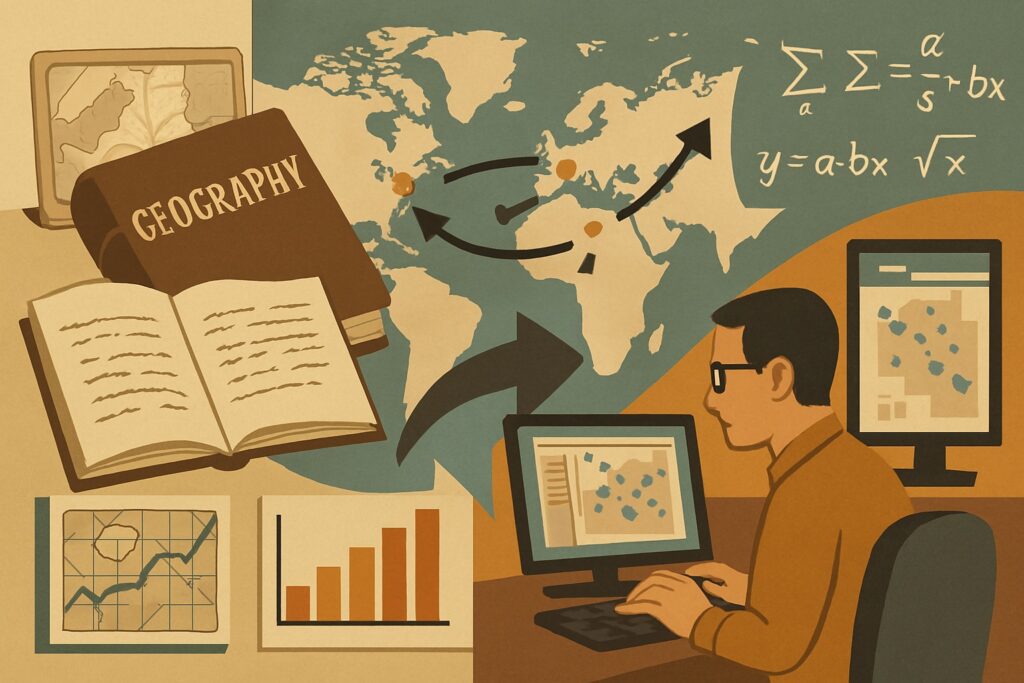The Quantitative Revolution was a major shift in the discipline of geography that occurred in the mid-20th century, particularly in the 1950s and 1960s. It was characterized by a focus on the use of mathematical and statistical methods in geographical research, as opposed to more qualitative and descriptive approaches.
It marked a fundamental change in the way geographical research was conducted, moving away from a predominantly descriptive and regional approach towards a more analytical, theoretical, and scientific methodology.

Table of Contents
What is the Quantitative Revolution?
The quantitative revolution refers to the shift from traditional qualitative methods of geographic research to more quantitative methods, including the use of statistical analysis, mathematical modeling, and computer mapping. This revolution occurred in the mid-20th century and marked a major turning point in the field of geography, as geographers began to use quantitative methods to analyze and understand geographical patterns and relationships.
It was inspired by developments in the natural sciences and social sciences, particularly advances in statistics, computing, and mathematical modeling. Geography, which had traditionally been seen as a descriptive and regional discipline, began to embrace these quantitative methods as a means of achieving greater objectivity and rigor in its research.
It led to the development of new research techniques, such as spatial analysis, mathematical modeling, and geographic information systems (GIS). It also gave rise to new subfields of geography, such as quantitative geography, which focused specifically on the application of mathematical and statistical methods to geographical research.
Criticism of Quantitative Revolution
Critics of the Quantitative Revolution argued that it led to a narrow and mechanistic view of geography, and that it neglected important social, cultural, and political factors that shape human behavior and environmental processes.
Despite these criticisms, however, the Quantitative Revolution had a lasting impact on the discipline of geography, and its methods continue to be used and refined today.
Impact on Locational Analysis
The quantitative revolution had a profound impact on locational analysis, a key aspect of geography that deals with the study of the location and distribution of human and physical features on the Earth’s surface. The use of quantitative methods and technologies has enabled geographers to analyze and understand complex locational patterns and relationships in much greater detail.
One of the most significant impacts of the quantitative revolution on locational analysis has been the ability to analyze and understand the spatial distribution of human and physical features. This includes the study of population distribution, migration patterns, urbanization, and economic development. With the use of sophisticated computer mapping and analysis tools, geographers can now produce high-resolution maps and visualizations that provide a comprehensive understanding of locational patterns and relationships.
Another impact of the quantitative revolution on locational analysis has been the ability to use statistical and mathematical models to analyze and understand the factors that influence the location and distribution of human and physical features. For example, geographers can now use regression analysis to examine the relationship between economic development and population growth, or spatial econometrics to examine the relationship between land use and economic activity.
Finally, the quantitative revolution has also had a significant impact on the field of spatial analysis, which is concerned with the study of the spatial relationships and patterns between different features on the Earth’s surface. With the use of spatial analysis tools and techniques, geographers can now analyze and understand the relationships between land use, economic activity, and environmental factors, providing a more comprehensive understanding of the geographical context in which these relationships occur.
Conclusion
In conclusion, the quantitative revolution has had a profound impact on the field of geography and has transformed the way in which geographers analyze and understand locational patterns and relationships. The use of quantitative methods and technologies has enabled geographers to produce high-resolution maps and visualizations, analyze complex relationships, and provide a more comprehensive understanding of the geographical context in which human and physical features are located.
Read: Geography Notes